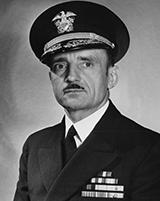
United States Navy (Ret.)
"Seabees" Founder
Lewis Combs was born in 1895 in Manchester, Vermont. His family later moved to the City of Rensselaer, and from there he became an RPI student. Graduating with his degree in civil engineering in 1916, he was commissioned a lieutenant junior grade in the Navy Civil Engineering Corps shortly after the United States entered World War I. In February 1918, he reported as Civil Engineer in Charge of Field Construction at the Navy Yard in Washington DC, where he served through September 1919. His next assignment was as a Treaty Engineer in the Republic of Haiti. In this assignment, he served as Assistant to the Engineer Chief, and Director of Highways and Bridges, Harbor Development and Lighthouse Service. For his outstanding work and contribution he received a letter of Commendation from the President of Haiti.
Returning to the United States in June 1924, he was assigned to the Navy Yard, New York, and in February, 1925, to the Navy Yard, Portsmouth, New Hampshire. In April 1929, he reported as Senior Assistant to the Public Works Officer and Executive Officer for the Eleventh Naval District, San Diego, California. He remained there until January 1932, when he became Public Works Officer with the ninth Naval District. Ordered to the Philippine Islands, he served from May 1935, through April 1937, as Public Works Officer, Sixteenth Naval District, at the Navy Yard, Cavite.In May 1937, then Commander Combs, reported to the Navy Bureau of Yards and Docks as Officer in Charge of Construction at the Navy Experimental Model Basin, Carderock, Maryland. In January 1938, at the relatively young age of 42, Commander Combs was appointed Assistant (Deputy) Chief of the Bureau of Yards and Docks, under Admiral Ben Moreell. In that capacity, he presided over the expansion of the Navy Civil Engineering Corps from a small group of 120 Officers and about 300 civilian engineers, to a wartime peak of over 10,000. In addition to overseeing the vast expansion of naval shore bases necessary to support the, “Two Ocean Navy,” Combs directed the creation of the Navy’s Construction Battalions. Now famously known as the Seabees, these units became the construction arm of the Navy and Marine Corps fighting forces, and accompanied them in every campaign from 1942 to present. Along with his Chief, Admiral Ben Moreell, Lewis Combs is credited with founding this unique organization. He held the position as Deputy Chief of Civil Engineers, from 1938 through 1946, an unprecedented eight years, twice the normal term for that position.
Having reached the rank of rear admiral, the highest level normally open to a Navy Civil Engineer Corps Officer at that time, Combs retired after thirty years of service. In 1948, he returned to Rensselaer as head of Civil Engineering Department and Professor of Civil Engineering. Many leaders of today’s civil engineering profession and construction industry received their RPI degrees under his tutelage during his fourteen-year tenure.
It is important to note that over the history of the Navy Civil Engineering Corps, more CEC officers have earned their degrees from RPI than any other engineering school, most likely a direct result of Lewis Combs influence, and certainly a tribute to his legacy.